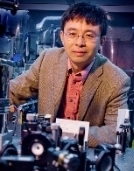 CHEMISTRY DEPARTMENT WELCOMES PROFESSOR XIAOYANG ZHU
CHEMISTRY DEPARTMENT WELCOMES PROFESSOR XIAOYANG ZHU


An exciting milestone for the chemistry department, beginning in January, 2013, has been the arrival of the research group of Professor Xiaoyang Zhu. Professor Zhu joins the Columbia chemistry department from the University of Texas at Austin, where he was the Louis Nicolas Vauquelin Regents Professor of Chemistry. Professor Zhu’s group initially consists of ten graduate students and post-doc’s, with five more researchers to arrive shortly. In fall 2013, the Zhu group will move into new laboratories that are currently being designed for portions the 12th and 13th floors of the Northwest Corner building. A temporary lab on the 5th floor of Havemeyer is being used by the group until the new labs are ready for occupancy.
Professor Zhu received a BS degree from Fudan University in 1984 and a PhD from the University of Texas at Austin in 1989. After postdoctoral research with J. Mike White at UT-Austin and Gerhard Ertl at the Fritz-Haber-Institute, he joined the faculty at Southern Illinois University as an Assistant Professor in 1993. In 1997, he moved to the University of Minnesota as an Associate Professor, later a Full Professor and Merck endowed Professor. In 2009, Professor Zhu returned to Austin and joined the chemistry faculty. His honors include a Dreyfus New Faculty Award, a Cottrell Scholar Award, a Friedrich Wilhelm Bessel Award, and Fellow of the American Physical Society. Among his professional activities, he serves on the editorial/advisory boards of Progress in Surface Science and Accounts of Chemical Research, and also as Chief Technology Officer at MicroSurfaces, Inc.
An important research thrust in the Zhu lab is to establish new photophysical mechanisms that may be utilized to revolutionize solar energy conversion. One of the key questions we are focusing on is at the heart of future photovoltaic technology: How can one extract electrons and holes from photo-generated excitons in organic semiconductors or inorganic quantum dots? To answer this question, the Zhu group uses model material systems and state-of-the-art laser spectroscopic techniques, including femtosecond time-resolved two-photon photoemission spectroscopy (2PPE) and time-resolved second harmonic generation (SHG). As examples, recent discoveries in their lab showed how an electron and a hole are bound by the Coulomb potential across an organic semiconductor interface, how one can extract hot electrons from a photoexcited quantum dot, and how an exciton can split into two to give two electron-hole pairs from the absorption of one photon. Answers to these questions have enabled the Zhu group to formulate new solar energy conversion strategies with power conversion efficiency approaching or exceeding the so-called Shockley-Queisser limit, which is the fundamental limit of conventional solar cells.
Another interest of the Zhu group is the challenge of understanding many-body interactions in condensed matter, such as electron-nuclear interaction leading to polaron formation in organic semiconductors and electron-electron interaction responsible for new physical properties in molecular or nanomaterials.
A smaller group project is aimed at understanding fundamental physical principles underlying bio-material interactions. The group is designing surface chemistry to rationally control such interfaces, e.g., the activity of proteins and stability of cell membranes. Recent highlights include the understanding of protein adsorption dynamics and multivalent cell surface interactions. |

